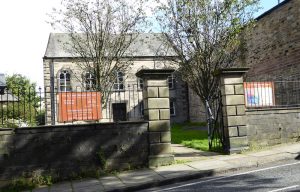
High Street Congregational Church (now URC), Lancaster
George Wright’s Christian faith would have been an important factor in his belief in the League of Nations
© Janet Nelson
By 1928, 10 churches or church organisations and 3 civic districts had become corporate members of the Lancaster League of Nations Union (LNU). All these were nonconformist, showing how important nonconformity was to the LNU. The only Church of England church to join as a corporate member was St. Anne’s. This figure is double Helen McCarthy’s findings that in 1928 there were five times as many nonconformists as Church of England churches co-opted to their local branch nationally. (1)
In 1926, the Pleasant Sunday Afternoon (PSA) Brotherhood, the Congregational men’s society, together with the Free Church Council, became the first two religious organisations to become corporate members of Lancaster LNU. By 1928, the two Congregational churches in Lancaster also became corporate members. Rev. F. J. Fry (Minister 1913-1923) of High Street Church (2) was at the inaugural meeting of Lancaster LNU in October 1920, and elected a Vice-President in 1921. Three of the most active Lancaster LNU officials, Alderman Wright , Chairman in 1924, and Mr and Mrs Dowbiggin , joint Secretaries, attended High Street Church. The High Street Schoolroom was used for a rally during the Peacemakers’ Pilgrimage overnight stay in Lancaster in 1926. The minister at the Centenary Church, Rev. E. J. Lawson (Minister 1920-1930) was one of the League’s most energetic activists.
References/Further Reading:
(1) H. McCarthy, 2011. The British People and the League of Nations. Manchester: Manchester University Press, ch.3.
(2) The Surman Index Online.
Lancaster Guardian, 3 Apr 1926, 21 Apr 1928 & 5 Jun 1926.

